
Submitted 13th August 1996
This version posted to the Web on 8th October 1996. Thumbnail images added 10th December
 |
This is an edited version of the project's official report
on its first year of activity, which was submitted to the funding body,
the Electronic Libraries programme.
It is a formal report, and some of the information it contains, especially
that referring to the technical implementation, has been superseded. If
you are interested in the technical framework, please refer to the latest
information.
Submitted 13th August 1996 This version posted to the Web on 8th October 1996. Thumbnail images added 10th December |
For this report, it is worth elaborating formally the overall objective for the project as well as the objectives for the first year, against which progress reported here can be judged.
To build a framework for commercial publishing applications which enables online journals (published on the Web) to be interlinked, and to provide users with the ability to create or follow numerous, flexible linked paths designed to support themed study and research using the maximum available online resources.The outline plan for year 1 that accompanied the original proposal, and which was later formalised in the year 1 plan (Appendix 1), was to build a first implementation based on a single journal. That plan can be encapsulated in the following set of objectives.
Progress has been good. Almost all the first year objectives have been achieved within the predicted timescale. In fact, the set of first year objectives understates the achievements of the first year since the project has extended its support among all interested parties: for academic journals these include commercial journal publishers; also editors, authors, readers and academic librarians (or users, as we will collectively call them here). In particular the project has established significant new contacts with publishers to provide additional working materials for subsequent years in biology and other disciplines.
In biology, the Company of Biologists has been involved in the project from the beginning. Two other publishers active in this area joined at the beginning of 1996. Electronic Press (EP), a unique online publisher of materials in biology and medicine, hosts the BioMedNet club for biomedical scientists and publishes journals owned by EP as well as presenting the online versions of journals of many other publishers. Academic Press (AP) has wider subject interests and since the beginning of the year has made all of its journals, over 180 titles, available online, the largest collection of online journals from a single publisher.
The original project partners in computer science were the British Computer Society and Oxford University Press, through their joint publishing enterprise, and John Wiley & Sons. This group now includes MCB University Press which principally publishes business materials but which also has an abstracts service in computing .
Stevan Harnad's online journal Psycoloquy, as well as papers from the Cambridge University Press journal which he edits, Behavioural and Brain Sciences (BBS), continue to be the main resources in cognitive science. It is anticipated that the cognitive science e-print archive recently funded by JISC within the eLib programme, as well as the Los Alamos e-print archive which is mirrored on the same machine, will also be integrated within the Open Journal framework.
In addition, we are close to confirming an arrangement of great significance to the project with the Institute for Scientific Information (ISI) and BIDS for access to comprehensive databases of abstracts, and we have continuing contacts with a number of academic publishers - Blackwell Science, Kluwer, Cambridge University Press among them - with a view to their possible participation later in the project.
Already, the interface components developed at Southampton University
have evolved through different implementations. The DMS first adopted a
File Manager-type structure but has since been rewritten in Sun's Java
language to make it faster and more dynamic.
 Fig.
1 Early document management system interface (31 kb .gif image)
Fig.
1 Early document management system interface (31 kb .gif image)
The first link service required users to install a piece of software
on their machine, a 'plug-in' application.
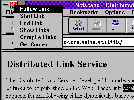 Fig.
2 Browser plug-in application provides extra menu of actions
Fig.
2 Browser plug-in application provides extra menu of actions
A recent version adopts a Web-based philosophy and makes the service
available remotely to users, who connect to the service as a proxy server,
rather than having to manage software on their own machines.
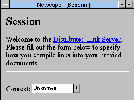 Fig.
3 Sample session form for proxy link service
Fig.
3 Sample session form for proxy link service
Adding links in pdf, for those journals viewed through Acrobat, is more
complex than for the Web's native html. Acrobat is optimised for page reproduction,
and despite the inclusion of improved link facilities in recent releases,
the underlying format makes it difficult to locate, place and highlight
links. To support the linking features sought by the project, the Electronic
Publishing group at Nottingham University has demonstrated a plug-in application
that adds the required link functionality.
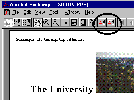 Fig.
4 Acrobat link plug-in adds to standard menu
Fig.
4 Acrobat link plug-in adds to standard menu
Some work has been aimed at longer-term features of an Open Journal, such as investigating more sophisticated search and information retrieval tools than are currently provided for the project's journals. This will become more important as the volume of information grows. Research on the application of intelligent agents in an Open Journal environment is ongoing.
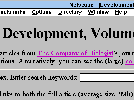 Fig.
5 Search engine applied to Development
Fig.
5 Search engine applied to Development
In contrast, the ten review journals, associated databases and abstracts service made available to the project by EP are accessed by arrangement with its subscriber service. Although access to these materials must be restricted to specified project users, this was considered the most appropriate arrangement for this range of materials. All are available in html.
An unusual feature of the biology resources is the Dictionary of Cell Biology. This is published in paper form by AP, and although the full text cannot be viewed online, there is a service which allows search requests for particular terms. Using a list of keywords supplied by the dictionary editor, the project extends these versions by linking TO the dictionary from any instance of a term that appears in it, from say an article in Development. This linking is mediated through the link service and can be switched on or off according to preference.
In cognitive science, Psycoloquy has for some time been hosted on a number of servers worldwide, and BBS has recently launched a Web site. Both are open access sites with a large volume of material. Early in the project, assistance was given to create hypertext versions of these sites.
Resources in computer science are building more slowly. After a delayed start, BCS/OUP's The Computer Journal is now each month expanding its online collection of full-text papers from the journal. Wiley has been developing electronic editions of selected journals through the CAJUN project with Nottingham University. These editions have been released on CD, but Wiley is now embracing an online publishing strategy and the project expects to have access to the journal Electronic Publishing-ODD. This journal and The Computer Journal will be hosted by the publishers rather than the project, and are in pdf format. MCB's Computer Abstracts Online is also publisher-hosted with privileged access for the project.
The above are the arranged materials. One of the features of an Open Journal is the ability to link FROM other, third-party resources which are openly accessible on the Web. A wide range of relevant resources has been discovered, including new Web journals, the abstracts of established paper journals (full text is not commonly available for such journals, and is usually subscriber-only when it is), university ftp archives and databases. Once again, biology is particularly richly served in this area.
To discover the extent and nature of these online resources, the project surveyed full-text scientific journals and published an extensive report [ref. 1].
To this end the project has produced a range of materials: a press release targetted at journals serving publishers and users across higher education; electronic postings on relevant mailing lists; technical papers for Web developers at two of the prestigious international Web conferences [ref 2][ref 3]; as well as papers intended for librarians, publishers, editors, authors, readers and everyone else involved in developing online journals [ref. 1][ref 4]. At the end of the first year the project fulfilled its plan to hold a full-day seminar, in London, for partners, users and invited guests, to demonstrate and discuss the project in a publishing context [ref. 5]. This seminar was perhaps the project's most vivid learning experience so far.
The press release resulted in a short feature in the Times' weekly Interfacesupplement on computing. It was also reported in technical journals and journals aimed at information scientists.Better targetted and immediate circulation can now be achieved with electronic mailing lists, which produced useful feedback.
Perhaps the most effective means to date of promoting the project has been by indirect reference, that is, through papers and correspondence that put the work in a wider perspective. The journals survey paper is an example [ref. 1].
An offshoot of this development is a new, and separate, collaboration with EP to add link services to its BioMedNet service. This online service, now launched into its commercial phase, imposes requirements on the link service that immediately differ from the longer-term horizons of the project, although results from both implementations will inform the larger applications possible in the future. BioMedNet will also bring greater visibility to the link service, which is central to the project strategy, and is significant recognition for the project from the UKís first online science publisher.
The survey paper, published on the Web and thereby promoting the project philosophy in word and deed, has been widely read and favourably commented upon. The paper is also to receive recognition in print as the invited paper in the 1996 Directory of Electronic Journals, Newsletters and Academic Discussion Lists published by the American Association of Research Libraries.
Hypertext links are fast becoming the currency of the Web, and the prospect is for their use to multiply dramatically. One major learned society, the Association for Computing Machinery, has stated in its electronic publishing plan that it will treat links as citations, that is, it will encourage the use of links to and from its published, and otherwise proprietary, materials. We are, however, only at the beginning of a major cultural change. Many US media professionals - journalists and producers, many from established national and regional TV stations or newspapers as well as from new Web publishing start-ups - recognise of the power of links and are visibly adding greater numbers of links to commercial online products. In the US there is a large and rapidly growing online user base, to the extent that we might speculate that the market there for new media developments is 2-3 years ahead of the rest of the world. The best ideas will migrate quickly, as will the new demands this generates.
This is by way of saying that the overall vision of an Open Journal remains strong and unchanged. Nevertheless, the learning process of the first year has informed perspectives on the implementation technologies, the nature and speed of the cultural change, and presentation skills. These experiences are discussed below.
The Web has become a multilayered technology, its great strength being the ability to integrate new and old technologies. The Web can present new types of hypertext-linked, Java-based multimedia materials. As authoring support and plug-in viewers proliferate, by next year there will hardly be a single mainstream application - from word processing to spreadsheets and presentations - that does not have a facility for generating something that can be viewed on the Web. The long-term divide between different computer platforms will be challenged, it is argued, by the emergence of the Network Computer, of limited capabilities but for which the network itself provides the computing power.
The present reality of the extent of this integration, however, is that not every user can experience the same view of all the Web has to offer. The problem: synchronisation, in other words, you can't always have what you want when you want it. The project has discovered this problem on a smaller scale. The aim of the project is to add enhanced link functions not to a single application but to a range of Web applications, notably Web browsers and Acrobat viewers, as has been mentioned already. Initially this link service was 'attached' to the various applications using software written in the Multimedia Research Group at Southampton University. It worked well in the laboratory, but it had problems with new versions of Netscape, the Macintosh version needed additional support, and the code has to be rewritten to work with Windows 95.
Add the development overhead to the user overhead of installing new software, and it became clear a new strategy was required. Link functions are now provided from a remote server and are seen by the user simply as an additional Web page (Fig. 3). Integration with the Web is therefore optimal, but for the Open Journal it is not yet seamless: enter Acrobat. Currently Acrobat does not have the same level of communication with Web servers, and the interpretation of link commands must be accomplished within the viewer, so the attachment lives on. Despite the short delay this redesign has caused in the schedule, an improved interface will be made available to users early in the second year of the project. In the context of the project as whole the new interface marks major progress.
A critical issue the project must solve is that of creating high quality
links in volume. The project has demonstrated the application of links
on a large scale, but not yet the effectiveness to produce only useful
links on the scale that commercial link publishing will demand..
 Fig.
6a Original page without links (Note. Large file. This is combined
with Fig. 6b for download forming a 62 kb .gif file.)
Fig.
6a Original page without links (Note. Large file. This is combined
with Fig. 6b for download forming a 62 kb .gif file.)
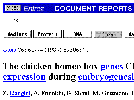 Fig.
6b Links added by link service
Fig.
6b Links added by link service
How can the automation features of the link service be moderated to
ensure quality links? First tests with biology links have begun to indicate
what a quality link is, but it can differ for a given user or group of
users. This development involves what we shall call the 'cognitive link
overhead', that is, the link editing task requires detailed knowledge of
the subject, the resources and the effects and characteristics of the link
service. Reducing this overhead is a top priority when the new interface
is available.
The projectís development programme includes longer-term research into the application of intelligent agents and the more immediate interface issues. During the second year the two threads will begin to converge. Despite the longer-term ambitions for intelligent agents within the project, this work will play a key role in helping us understand the cognitive link overhead discussed above. Bringing the agent work closer to the journal interface, specifying agent tasks and building real applications, will illuminate both the cognitive and technical link creation processes.
Another culture gap is that between traditional publishers, who own the print journals, and the new generation of would-be Web publishers. A publisher can be both at the same time, but the gap is still there. Traditional publishers are naturally conservative and, under pressure to preserve commercial profitability, are faced with a new medium that has not demonstrated the capacity for sustained revenue generation. Such publishers are not inclined to be 'open' in the same terms that support the Web philosophy; the publishing process itself is staunchly resistant to any apparent form of standardisation: 'the anti-Procrustean tendency is strongly represented' said one publisher.
It is against this background that the project has to involve publishers in developing new products that may, or may not, be consistent with their existing commercial strategies, and for which the demand from the academic community is unclear. An added dimension for the project is the extension of the Web culture to its underlying link culture.
In fact, the popularity of the Web has generated a momentum all of its own, even among publishers, so the barriers are not as great as they may at first seem. Beyond our original partners, those UK publishers with the most active programmes for putting journals on the Web, EP and AP for example, were first to approach us and have been enthusiastic from the outset.
That said, involving new publishers in the project has had to be handled carefully, openly and with as many demonstrations as could be provided. Participation does not demand, or imply, similar views, just an open mind and a willingness to explore new possibilities in a controlled environment.
The issue has thus proved to be manageable on a relatively local scale, within the UK say, when it involves a focussed audience. Our ambition is to convince a larger constituency of publishers and academic users of the benefits of the approach, but this will have to be achieved without the same scope for individual contact. How can we best use the Web to bring hands-on experience to a range of users given the technology issues discussed above and the limitations of current online resources or the conditions imposed on our use of them? These are real publishing questions for the project to answer.
As with publishers, first reactions from our target user group have been positive. The London seminar provided the first opportunity to meet many from this group and demonstrate the Open Journal approach. Perhaps one of the most convincing arguments in favour of the approach was given at the meeting not by the project team but by the biology open journal editor David Shotton, who is also one of the test users. Within the biology field our problem will not be persuading users to use an Open Journal, but to amply fulfill the latent demand among this group.
The meeting was held to bring together for the first time as many of the projectís diverse participants as possible, to give everyone the same view of the latest implementation of the biology Open Journal, and to seek feedback. Speakers included publishers and users as well as the project developers. All participants were invited to comment informally at any time during proceedings, which many did, and there was a general discussion session. Thus, although attendance was by invitation only, the content of the meeting was truly Ďopení.
In addition to the above objectives, we were also aware that the seminar would be a forerunner of more public demonstrations to be held later in 1996 and beyond. To be given the experience of presenting such a meeting in front of a supportive and tolerant audience was invaluable.
Despite achieving our immediate objectives, the meeting provided some hard lessons. The demonstrations reinforced the need for thorough testing of the interface some way in advance of a meeting, although this is not easy in mid-development. Themed meetings have to be more carefully scripted than typical, broader seminars, with all speakers aware in advance of other presentations. The overall message has to be coherent and complete. While open discussion can be enlightening, it requires some control, and speakers discovered the importance of pace and direction in motivating and handling this type of feedback.
The project is creating a more formal framework for the specialist test users, involving structured as well as exploratory use of the interface and the various resources. Responses will be monitored through questionnaires, individual meetings and group sessions where possible. The Web, however, will be the principal means of communication, for issuing materials and inviting immediate response.
The task of achieving sustainability beyond the project will require corporate change, risk and new investment. To justify this, commercial players must be convinced of the reliability and accessibility of the technical infrastructure, satisfied with the legal framework, yet prepared to relinquish some currently demanded rights and be amenable to greater cooperation between commercial interests. Most importantly, they will want evidence of a significant switch in the market for the product, in this case towards online scholarly information. The commercial players must remember, however, that they cannot control this change; it is their speed of response to the change, to the changing publishing culture, that will be critical in their own success.
Increasingly, the projectís technical advances will be tempered by user preferences and the commercial framework. This framework will likely not be the one that exists now, but it will ultimately be commercial. How the project balances these outcomes will determine the longer-term viability of the Open Journal model.